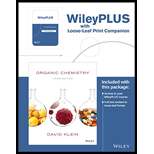Solutions for Organic Chemistry, 3e WileyPLUS Registration Card + Loose-leaf Print Companion
Browse All Chapters of This Textbook
Book Details
In Organic Chemistry, 3rd Edition, Dr. David Klein builds on the phenomenal success of the first two editions, which presented his unique skills-based approach to learning organic chemistry. Dr. Klein's skills-based approach includes all of the concepts typically covered in an organic chemistry textbook, and places special emphasis on skills development to support these concepts. This emphasis on skills development in unique SkillBuilder examples provides extensive opportunities for two-semester Organic Chemistry students to develop proficiency in the key skills necessary to succeed in organic chemistry.
Sample Solutions for this Textbook
We offer sample solutions for Organic Chemistry, 3e WileyPLUS Registration Card + Loose-leaf Print Companion homework problems. See examples below:
More Editions of This Book
Corresponding editions of this textbook are also available below:
